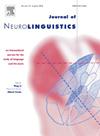Cerebral reorganization patterns predicting language recovery in individuals with post-stroke anomia: Evidence from functional near-infrared spectroscopy
IF 1.2
3区 心理学
Q2 LINGUISTICS
引用次数: 0
Abstract
This study integrates functional near-infrared spectroscopy (fNIRS) with network-based statistics (NBS) to investigate the brain functional reorganization patterns in patients with post-stroke anomia (PSA) and their relationship with language recovery. The study included 28 patients with mild to moderate PSA and a matched healthy control group (HC). A parallel controlled trial design was employed to compare neural and behavioral changes before and after language intervention between the normal treatment (NT) and deferred treatment (DT) groups. The results revealed that: (1) in PSA patients, activation of the left hemisphere Broca's area and supramarginal gyrus (SMG) was significantly reduced during an overt naming task, while compensatory activation in the right hemisphere inferior frontal gyrus (IFG) was enhanced; (2) following treatment, the NT group exhibited a significant increase in hemodynamic responses and functional connectivity in the left hemisphere premotor and supplementary motor area (pSMA), Broca's area, and SMG, accompanied by a reduction in right hemisphere activation, whereas the DT group relied primarily on inefficient reorganization within the right hemisphere and visual cortex; (3) graph theory analysis demonstrated a significant positive correlation between node centrality in the left hemisphere Broca's area and SMG, as well as improvements in naming accuracy and language scores. The study confirms that efficient reorganization of the left hemisphere language network is a core mechanism underlying PSA recovery, with targeted language therapy promoting functional compensation through network integration, while spontaneous recovery depends on atypical pathways. This study provides dynamic evidence for the neuroplastic mechanisms of post-stroke language impairment and supports neuroimaging-based evidence for early clinical intervention.
脑重组模式预测脑卒中后语言障碍患者的语言恢复:来自功能性近红外光谱的证据
本研究将功能近红外光谱(fNIRS)与基于网络的统计学(NBS)相结合,探讨脑卒中后异常异常(PSA)患者的脑功能重组模式及其与语言恢复的关系。该研究包括28例轻度至中度PSA患者和匹配的健康对照组(HC)。采用平行对照试验设计比较正常治疗组(NT)和延迟治疗组(DT)语言干预前后的神经和行为变化。结果表明:(1)PSA患者在显性命名任务中,左半球布洛卡区和边缘上回(SMG)的激活显著降低,而右半球额下回(IFG)的代偿性激活增强;(2)治疗后,NT组表现出左半球运动前和辅助运动区(pSMA)、Broca区和SMG的血流动力学反应和功能连接显著增加,同时右半球激活减少,而DT组主要依赖于右半球和视觉皮层内低效的重组;(3)图论分析表明,左半球Broca区节点中心性与SMG显著正相关,命名准确率和语言分数也有显著提高。该研究证实,左半球语言网络的有效重组是PSA恢复的核心机制,有针对性的语言治疗通过网络整合促进功能补偿,而自发恢复依赖于非典型途径。本研究为脑卒中后语言障碍的神经可塑性机制提供了动态证据,并为早期临床干预提供了基于神经影像学的证据。
本文章由计算机程序翻译,如有差异,请以英文原文为准。
求助全文
约1分钟内获得全文
求助全文
来源期刊

Journal of Neurolinguistics
医学-神经科学
CiteScore
3.90
自引率
5.00%
发文量
49
审稿时长
17.2 weeks
期刊介绍:
The Journal of Neurolinguistics is an international forum for the integration of the neurosciences and language sciences. JNL provides for rapid publication of novel, peer-reviewed research into the interaction between language, communication and brain processes. The focus is on rigorous studies of an empirical or theoretical nature and which make an original contribution to our knowledge about the involvement of the nervous system in communication and its breakdowns. Contributions from neurology, communication disorders, linguistics, neuropsychology and cognitive science in general are welcome. Published articles will typically address issues relating some aspect of language or speech function to its neurological substrates with clear theoretical import. Interdisciplinary work on any aspect of the biological foundations of language and its disorders resulting from brain damage is encouraged. Studies of normal subjects, with clear reference to brain functions, are appropriate. Group-studies on well defined samples and case studies with well documented lesion or nervous system dysfunction are acceptable. The journal is open to empirical reports and review articles. Special issues on aspects of the relation between language and the structure and function of the nervous system are also welcome.
 求助内容:
求助内容: 应助结果提醒方式:
应助结果提醒方式:


